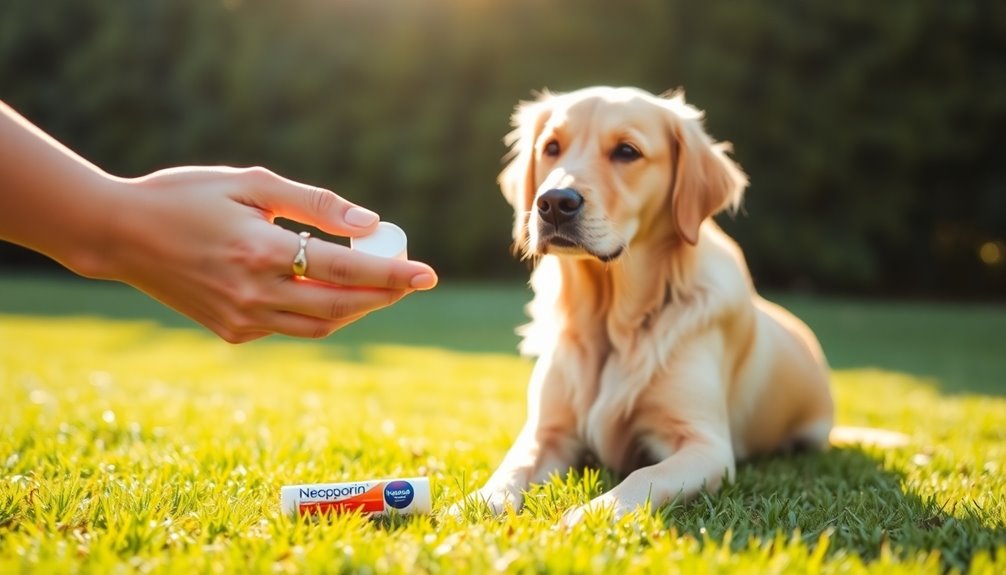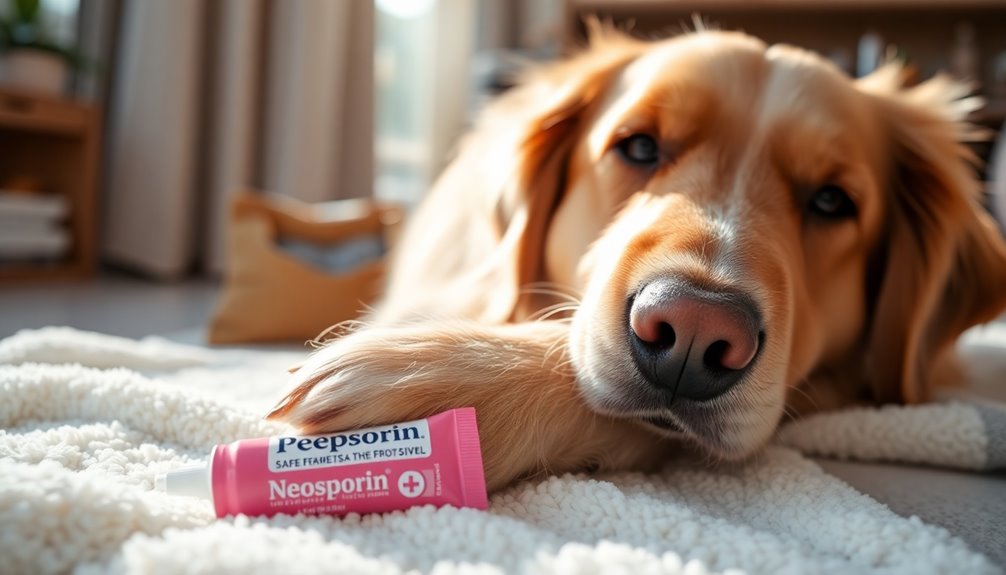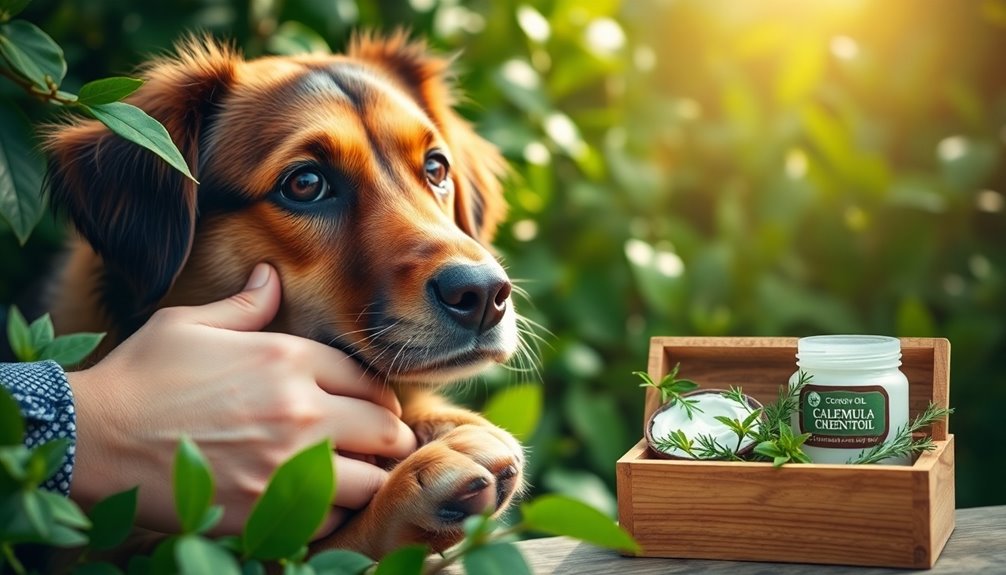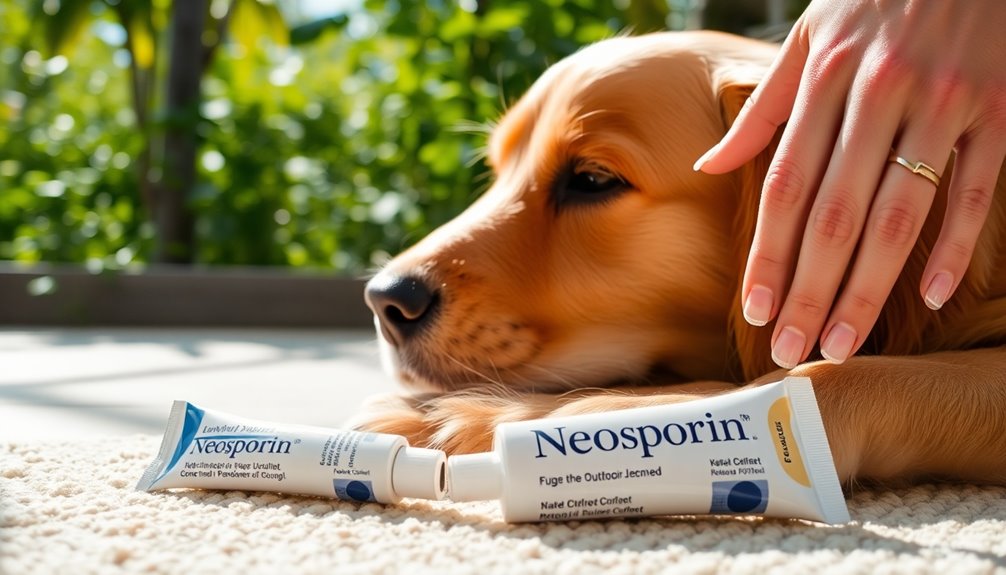You can use Neosporin on your dog for minor cuts and scrapes, but be careful. Its ingredients can pose risks, especially neomycin, which may cause allergic reactions or gastrointestinal issues if ingested. Always clean the wound first and apply a small amount. Monitor for irritation, redness, or swelling, and use an Elizabethan collar to prevent licking. For large or deep wounds, consult your veterinarian instead. Remember, there are safer alternatives designed specifically for dogs that may be worth considering. If you're curious about those options or proper aftercare, there's more to discover!
Key Takeaways
- Neosporin can be used for minor dog wounds, but consult a veterinarian first to avoid potential allergic reactions or complications.
- Clean the wound with mild soap and water before applying a small amount of Neosporin to prevent infection.
- Monitor for signs of irritation or infection, such as redness, swelling, or discharge, and seek veterinary care if these occur.
- Avoid letting your dog lick the treated area by using an Elizabethan collar to prevent ingestion and complications.
- Consider veterinary-specific ointments or natural remedies as safer alternatives for treating minor wounds in dogs.
What Is Neosporin?

Neosporin is a popular brand of topical antibiotic ointment often used to treat minor cuts, scrapes, and burns in humans. This ointment contains three active ingredients: bacitracin zinc, neomycin sulfate, and polymyxin B sulfate, which effectively combat bacterial infections.
While Neosporin's formulation is designed for human use, its safety for dogs isn't assured, raising important considerations. It's effective against a wide range of bacteria but doesn't work on fungi or viruses, and it's not suitable for large or deep wounds.
Additionally, some dogs may experience allergic reactions when using Neosporin, so caution is essential. Always consult with a veterinarian before applying any topical ointment to your pet to guarantee their safety and well-being.
Is Neosporin Safe for Dogs?

When considering whether Neosporin is safe for dogs, it's important to weigh the pros and cons carefully. Neosporin is generally considered safe for minor cuts and scrapes when you apply a small amount. However, larger or deeper injuries require veterinary care. While bacitracin and polymyxin B are safe, neomycin can cause risks, including potential hearing loss.
Here's a quick overview:
| Pros | Cons |
|---|---|
| Safe for minor wounds | Allergic reactions possible |
| Acts as a protective barrier | Can cause gastrointestinal upset |
| Easy to apply | Shouldn't be ingested |
| Generally effective | Consult with a veterinarian |
Always consult with a veterinarian before using Neosporin to ascertain it's appropriate for your dog's specific needs.
Application Guidelines

Before you apply Neosporin, make sure to clean the wound with mild soap and lukewarm water.
Use only a small amount on minor injuries and keep an eye on the area for any signs of allergic reactions.
Clean the Wound First
Cleaning the wound thoroughly is vital for effective healing. To guarantee proper wound care before using Neosporin on dogs, follow these steps:
- Gently clean the wound with mild soap and lukewarm water to remove dirt and debris.
- Pat the area dry using a sterile cloth or gauze—avoid rough rubbing to prevent irritation.
- Ensure the area is completely dry, as moisture can hinder the ointment's effectiveness.
- Apply a small amount of Neosporin to the affected area to help prevent infection.
As a responsible pet owner, it's important to monitor the wound closely for any signs of irritation or infection, like increased redness or swelling.
Consult your veterinarian if you notice any concerning symptoms.
Apply Sparingly
After confirming the wound is clean and dry, it's time to apply Neosporin.
Remember, this ointment is safe for minor wounds and superficial injuries but should never be used on deep cuts or actively bleeding areas.
Use Neosporin sparingly; a small amount is all you need to treat the affected area. Gently apply it to minimize the risk of adverse reactions.
If your dog tends to lick the wound, consider using an Elizabethan collar to prevent ingestion and confirm the ointment remains effective.
By applying Neosporin properly, you can help prevent infections and promote healing.
Just keep an eye on your dog for any signs of irritation or allergic reactions, and discontinue use if needed.
Monitor for Reactions
How can you guarantee your dog's safety after applying Neosporin?
It's essential to monitor for reactions closely. Keep an eye out for:
- Allergic reactions: Watch for swelling, redness, or increased irritation at the application site.
- Gastrointestinal distress: Look for signs like vomiting or diarrhea, indicating your dog may have ingested the ointment.
- Signs of infection: Check for changes like pus or heightened redness, which need veterinary assistance.
- Licking: Use an Elizabethan collar to prevent your dog from licking the area, promoting effective healing.
If you notice any adverse reactions, stop using Neosporin on dogs immediately and consult your veterinarian for alternative treatments.
Your dog's health depends on your vigilance!
Potential Risks of Neosporin

While Neosporin may seem like a convenient solution for your dog's minor wounds, it's important to be aware of the potential risks involved.
Neomycin, an ingredient in Neosporin, can cause allergic reactions in dogs, leading to redness, itching, or swelling at the site. If your dog licks the Neosporin, it may ingest the ointment, resulting in gastrointestinal disturbances like vomiting or diarrhea.
There's also a risk of aspiration pneumonia if the ointment is inhaled during grooming. Additionally, Neosporin can disrupt the natural balance of bacteria on your dog's skin, potentially delaying healing and increasing the risk of skin infections.
Overuse can lead to antibiotic-resistant bacteria, complicating future treatments. Always prioritize your dog's safety.
Signs of Adverse Reactions

What should you look for when monitoring your dog after applying Neosporin? Keep an eye out for any signs of allergic reactions, as these can indicate adverse reactions.
Here are four key signs to watch for:
- Swelling or redness at the application site.
- Itching or rash, suggesting contact dermatitis, especially if your dog has skin sensitivities.
- Changes in behavior or appetite, which may signal discomfort or distress.
- Worsening of the wound, like increased redness, swelling, or pus.
If you notice any of these symptoms, seek veterinary assistance promptly.
Also, it's essential to prevent licking the treated area to avoid gastrointestinal disturbances, like vomiting or diarrhea.
Your vigilance can help guarantee your dog's safety.
Alternatives to Neosporin

When looking for alternatives to Neosporin for your dog, consider veterinary-specific topical products that are safe for pets.
Natural healing options like aloe vera and manuka honey can also be effective and gentle on their skin.
Don't forget about proper wound cleaning techniques to keep your furry friend healthy and happy.
Veterinary-Specific Topical Products
Choosing the right topical treatment for your dog is essential, and veterinary-specific products often stand out as safer alternatives to Neosporin.
These products are designed to be safe for dogs, minimizing the risk of infection and adverse reactions. Here are some options to take into account:
- Silver sulfadiazine – Effective against bacteria and treats minor wounds.
- Chlorhexidine sprays – Excellent for targeted treatment of infections.
- Pet-safe antiseptics – Formulated to be safe if ingested, reducing worry about licking.
- Manuka honey – A natural remedy with antibacterial properties that promotes healing.
Additionally, it's crucial to consult with your veterinarian for a professional diagnosis to guarantee the right product for your dog's specific condition.
Natural Healing Alternatives
While Neosporin is a common choice for wound care, many natural healing alternatives can be safer and just as effective for your dog. Here are some natural alternatives to Neosporin for dogs:
| Alternative | Benefits | Usage Tips |
|---|---|---|
| Antimicrobial Sprays | Prevent infections, safe if ingested | Apply as directed |
| Manuka Honey | Antibacterial, promotes healing | Apply directly to wounds |
| Aloe Vera | Soothes skin irritations, healing | Use gel on affected areas |
| Chlorhexidine | Effective antiseptic, canine-friendly | Clean wounds regularly |
| Consult a Veterinarian | guarantee safety and appropriateness | Always seek professional advice |
These options are generally safe for humans too, but always consult with a veterinarian before applying any treatments.
Proper Wound Cleaning Techniques
To guarantee your dog's wound heals properly, it's crucial to start with effective cleaning techniques before applying any treatment. Follow these proper wound cleaning techniques:
- Use mild soap and water to clean the wound thoroughly, removing dirt and debris.
- Gently pat the area dry with a soft cloth or gauze, making sure the skin isn't irritated.
- If you choose to use pet-safe antiseptics, verify they're specifically formulated for dogs to avoid adverse reactions.
- Apply a thin layer of any topical treatment, avoiding excess that might lead to licking.
Afterward, monitor the wound for signs of infection. If you notice increased redness, swelling, or discharge, consult a veterinarian promptly to guarantee your dog's health.
When to Consult a Veterinarian

Knowing when to consult a veterinarian is essential for your dog's health and well-being. If your dog has a wound that is deep, large, or actively bleeding, always seek immediate veterinary care instead of applying Neosporin. Be vigilant for signs of infection, such as increased redness, swelling, and pus. If the wound doesn't improve within a few days, it's time to consult a veterinarian. Additionally, if your dog experiences swelling, itching, or rash after using Neosporin, contact your vet right away. For wounds in areas prone to licking, it's best to consult a vet for appropriate treatment options.
| Situation | Action Required | Importance |
|---|---|---|
| Deep, large, or actively bleeding | Consult a veterinarian | Immediate veterinary care needed |
| Signs of infection | Monitor and consult a vet | Prevent worsening of the condition |
| Allergic reaction | Contact your veterinarian | Guarantee your dog's safety |
| Uncertain severity | Always reach out | Get professional guidance |
| Wound prone to licking | Consult a veterinarian | Find effective treatment options |
Best Practices for Wound Care

When caring for your dog's wounds, it's crucial to follow best practices to guarantee proper healing and prevent infection. Here's a quick guide:
- Clean the wound thoroughly with mild soap and lukewarm water to remove debris.
- Apply Neosporin in small amounts only to minor cuts, avoiding larger wounds that need veterinary attention.
- Monitor the wound for signs of infection, like redness or discharge, and consult your vet if necessary.
- Consider using an Elizabethan collar if the wound is in a spot your dog can easily lick, to prevent ingestion of the ointment.
Always do a patch test on a less sensitive area before applying Neosporin fully to verify no allergic reactions occur.
Frequently Asked Questions
Is It Safe to Use Neosporin on Dogs?
Using Neosporin on dogs isn't generally recommended without consulting a vet first.
While it may help with minor wounds, its ingredients can cause allergic reactions or upset stomachs if ingested. You should monitor your dog closely after applying it, watching for redness or swelling.
Instead, consider pet-specific wound care products or natural remedies, which are often safer and more effective for treating your furry friend's injuries.
Always prioritize their well-being!
What Antibiotic Ointment Can I Use on My Dog?
Imagine your dog bounding through the yard, only to return with a minor scrape. You want to help, but choosing the right antibiotic ointment is key.
Consider using bacitracin, silver sulfadiazine, or Polysporin—they're safer options than human products. Aquaphor can soothe dry skin as well.
Always consult your vet first to guarantee the ointment fits your dog's specific needs, keeping their health and safety a top priority.
What Happens if a Dog Licks a Little Neosporin?
If your dog licks a little Neosporin, it might cause some gastrointestinal upset, leading to symptoms like vomiting or diarrhea.
While small amounts usually aren't harmful, the ingredients can disrupt the balance of gut bacteria, resulting in disturbances.
You should keep an eye out for any signs of irritation or allergic reactions.
To prevent licking, consider using an Elizabethan collar or protective bandages on accessible wounds.
Always consult your vet if you're concerned.
Why Is Neosporin No Longer Recommended?
Like a double-edged sword, Neosporin's risks outweigh its benefits for dogs.
It's no longer recommended because it can trigger allergic reactions and gastrointestinal issues if ingested. The ointment isn't designed for pets, meaning it mightn't effectively treat their unique wounds.
Additionally, the petroleum ingredients pose serious health risks if licked off.
Instead, opt for pet-specific wound care products that guarantee your furry friend's safety and well-being.
Conclusion
In conclusion, while Neosporin might seem like a handy solution for your dog's wounds, it's essential to approach its use with caution. Always check with your vet before applying it, as some dogs can have adverse reactions. Remember, your furry friend isn't just a sidekick in this adventure—he's counting on you to keep him safe. So gear up, stay informed, and give your pup the best care possible!










